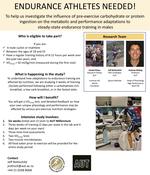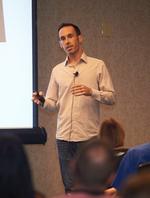Jeffrey Rothschild
Performance Nutritionist
High Performance Sport New Zealand
Biography
My goal is to provide world class nutrition support, using my background in sports nutrition, exercise physiology, data science, and research.
Experience
Sports Nutrition
I have been a sports dietitian since 2014, providing nutrition consultation to individual athletes as well as teams, including professional athletes, members of National and Olympic teams, and World Champions.
Research
I have designed, conducted, and published original research studies in peer-reviewed journals, and translated the findings into practical application for coaches and athletes.
Data Science
Applied data science is integral to my current practice as a sports dietitian and researcher, using the R programming language as part of my data collection, statistical analysis, data visualization, and to generate reports of my findings. I particularly love using unconventional or underutilized sources of data to uncover actionable insights. I have recently conducted two large-scale modelling projects using both linear models and machine learning techniques to better understand physiological factors influencing training adaptations, and created Shiny dashboards to make the findings accessible to a wider audience.
https://rothschild.shinyapps.io/carb-index-app/
https://rothschild.shinyapps.io/Energy-balance/
https://rothschild.shinyapps.io/AMPK_dashboard/
https://rothschild.shinyapps.io/RER_dashboard/
Interests
- Sports nutrition
- Exercise physiology
- Data Science
Education
PhD in Exercise Physiology, 2019 - 2023
Auckland University of Technology
M.S. Nutritional Science, 2014
California State University, Los Angeles
B.A. Music Production and Engineering, 2000
Berklee College of Music
Projects
Featured Publications
Acute effects of resistance exercise on skeletal muscle glycogen depletion A systematic review and meta-analysis
The aim of this study was to assess the acute effects of a resistance training session on muscle glycogen concentration.
Carbohydrate ingestion during prolonged exercise and net skeletal muscle glycogen utilization: A meta analysis
The aim of this meta-analysis was to determine if carbohydrate ingestion during endurance exercise reduces net skeletal muscle utilization, thus preserving muscle glycogen stores.
Durability of the moderate‑to‑heavy intensity transition can be predicted using readily available markers of physiological decoupling
The aim of this study was to (i) assess bivariate relationships between decoupling of heart rate, ventilation, and breathing frequency and durability of power output at the moderate-to-heavy intensity transition and (ii) assess the strength of practical models including decoupling measures to predict power output at the moderate-to-heavy intensity transition at multiple time points during prolonged exercise.
Nutritional Strategies to Improve Post‐exercise Recovery and Subsequent Exercise Performance A Narrative Review
The goal of this review is to synthesize the available research on nutritional strategies to enhance post-exercise recovery and subsequent exercise performance, defined as an exercise performance occurring within 2–24 h of a prior bout of exhaustive exercise.
A Novel Method to Predict Carbohydrate and Energy Expenditure During Endurance Exercise Using Measures of Training Load
We aimed to (1) quantify bivariate relationships between both CHO and overall energy expenditure (EE) dur- ing exercise and commonly used, non-invasive measures of training load across sessions of varying duration and intensity and (2) build and evaluate prediction models to estimate CHO utilization and EE with the same training load measures and easily quantified individual factors.
International society of sports nutrition position stand ketogenic diets
The International Society of Sports Nutrition (ISSN) provides an objective and critical review of the use of a ketogenic diet in healthy exercising adults, with a focus on exercise performance and body composition.
Predicting daily recovery during long-term endurance training using machine learning analysis
The goal of this study was to test the ability of machine learning models to predict perceived morning recovery status and daily change in HRV based on training metrics, dietary intake, sleep, HRV, and subjective wellbeing.
Locally applied heat stress during exercise training may promote adaptations to mitochondrial enzyme activities in skeletal muscle
The aim of this study was to determine if elevating muscle temperature during exercise through the application of mild, local heat stress would promote adaptations to mitochondrial protein content in response to endurance training.
Skeletal muscle proteins involved in fatty acid transport influence fatty acid oxidation rates observed during exercise
The purpose of this study was to investigate skeletal muscle proteins involved in fatty acid oxidation.
The influence of dietary carbohydrate on perceived recovery status differs at the group and individual level – evidence of nonergodicity among endurance athletes
The purpose of this study was to examine the relationship between daily carbohydrate intake and perceived recovery status and determine if group-level statistics can generalize to individual athletes.
A three-minute all-out test performed in a remote setting does not provide a valid estimate of the maximum metabolic steady state
The aim of the present investigation was to determine the reliability and validity of the 3MT for estimation of the MMSS when performed in remote settings by unsupervised athletes using their own indoor cycling setup.
Factors Influencing Substrate Oxidation During Submaximal Cycling - A Modelling Analysis
The purpose of this analysis was to investigate factors influencing the RER during cycling exercise and formulate regression models to determine which factors best explain RER during exercise, their relative influence, and the result of multiple variables being modulated simultaneously.
Factors Influencing AMPK Activation During Cycling Exercise - A Pooled Analysis and Meta‐Regression
The purpose of this analysis was to (1) investigate correlations between factors influencing AMPK activation and the magnitude of change in AMPK activity during cycling exercise, (2) investigate correlations between commonly reported measures of AMPK activation (AMPK-a2 activity, phosphorylated (p)-AMPK, and p-acetyl coenzyme A carboxylase (p-ACC), and (3) formulate linear regression models to determine the most important factors for AMPK activation during exercise.
Pre-Exercise Carbohydrate or Protein Ingestion Influences Substrate Oxidation but Not Performance or Hunger Compared with Cycling in the Fasted State
The aim of this crossover study was to determine the effects of three different pre-exercise nutrition strategies on substrate oxidation, performance during HIIT, and exercise-induced oxidative stress.
Racing and Training Physiology of an Elite Ultra-Endurance Cyclist - Case Study of 2 Record-Setting Performances
A case report of an elite ultra-endurance cyclist, who was the winner and course record holder of 2 distinct races within a 4-month span - a 24-hour solo cycling race (Bike Sebring 24 h) and a 2-man team multiday race (RAAM).
Effect of low- and high-carbohydrate diets on swimming economy - a crossover study
The aim of this study was to determine the influence of three days of high- and low-carbohydrate diets on the energetic cost of submaximal swimming.
What should I eat before exercise? Pre-exercise nutrition and the response to endurance exercise - Current prospective and future directions
The purpose of this review is to highlight the current knowledge of the influence of pre-exercise nutrition ingestion on the metabolic, physiological, and performance responses to endurance training. We also highlight areas for practitioners where evidence is lacking, particularly regarding trained athletes, and suggest directions for future research.
Pre-Exercise Nutrition Habits and Beliefs of Endurance Athletes Vary by Sex, Competitive Level, and Diet
The aim of this study is twofold. The first aim is to determine the self-reported beliefs and practices relating to pre-exercise nutrition intake among endurance athletes of varying ages and competitive levels. The second objective is to determine whether differences in nutrition practices or beliefs rela‐ ted to sex, competitive level, or habitual dietary pattern exist.
Prevalence and Determinants of Fasted Training in Endurance Athletes - A Survey Analysis
The aim of this study is to describe the prevalence and determinants of exercise performed in the overnight-fasted state among endurance athletes of varying backgrounds and competitive levels.
Influence of a 2-km swim on the cycling power-duration relationship in triathletes
This study was designed to determine how a 2-km swim affects the cycling power-duration relationship by having a group of triathletes perform a 3MT in a rested state and a 3MT immediately after a 2-km swim at half-iron distance triathlon intensity.



